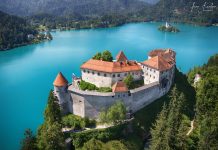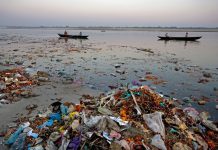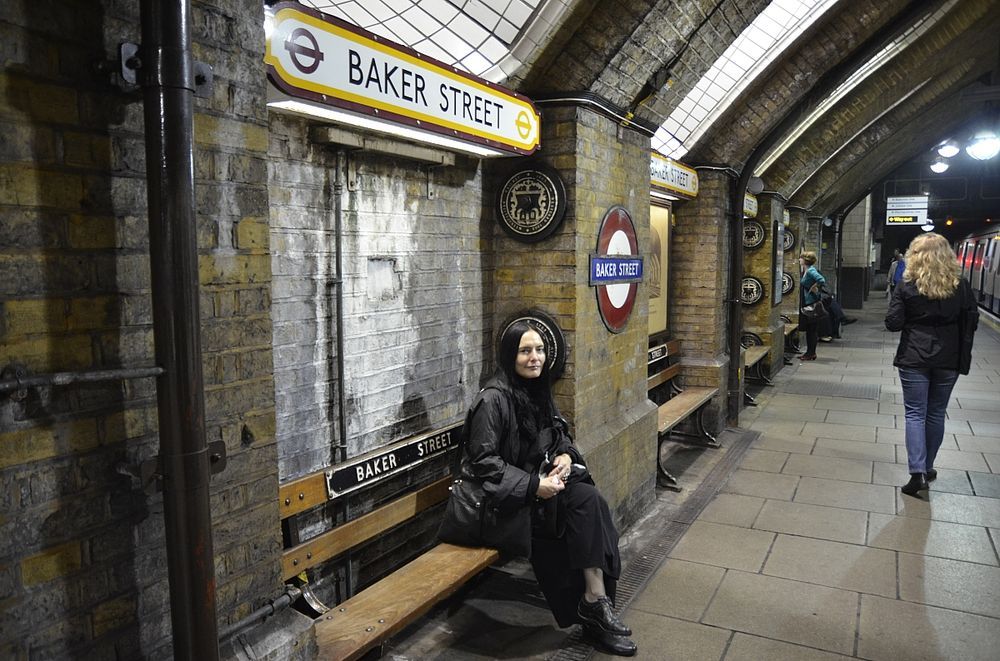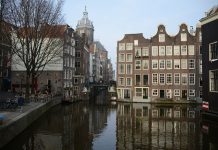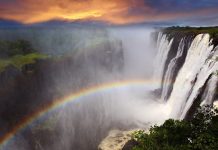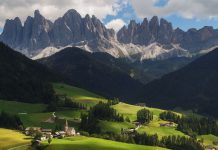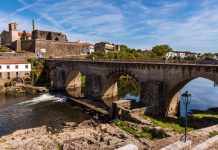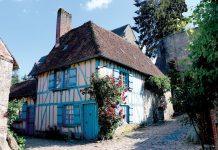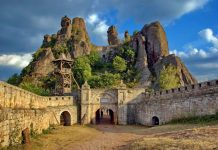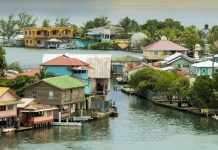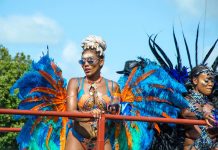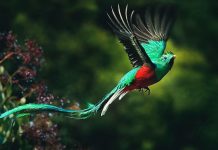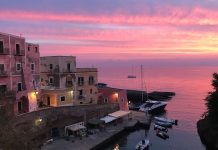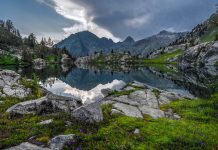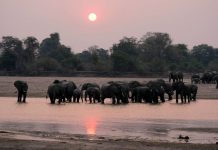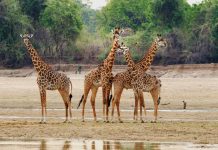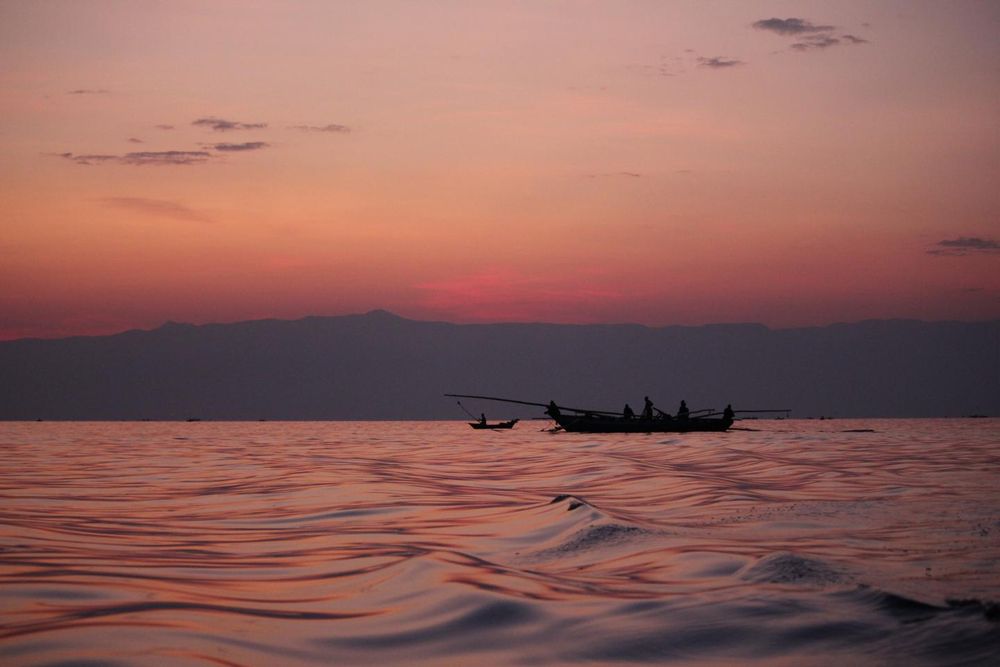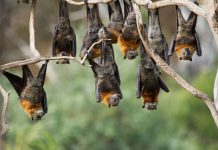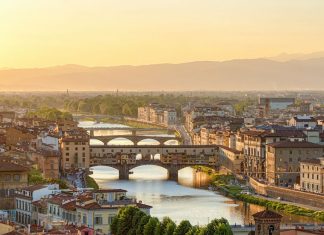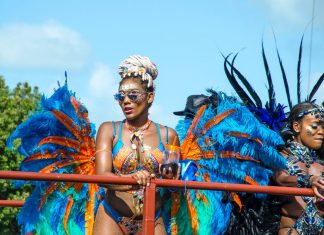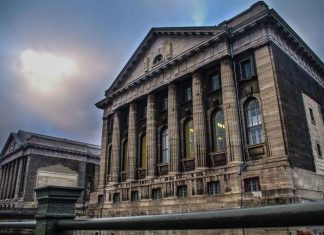This vast inland sea was first made known to the European world in the mid 1800’s by the English explorers Richard Burton and John Speke. They pursued it as the source of the Nile, arriving at its shores in February of 1858, only to discover that the Ruzizi River in the north, which they thought to be the Nile, flowed into and not out of the lake. (Their incredible journey is documented in the movie ‘Mountains of the Moon’.)
Tanganyika’s waters lap Tanzania, Burundi, Congo DR and Zambia. It is the longest fresh water lake in the world and the second deepest after lake Baikal in Russia. The immense depth is because it lies in the Great Rift Valley, which also has created its steep shoreline. It reaches a depth of 1433 metres (4 700 feet), which is an astounding 642m below sea level.
Although Zambia can only lay claim to 7% of its surface area, it stretches north to south a distance of 677 kilometres (420 miles) and averages about fifty kilometers wide (31 miles). The clear waters host more than 350 different species of fish and is well known for aquarium fish exports and excellent angling.
The fertile circulating surface water, although not tidal, provides abundant plankton for its inhabitants which in turn provides much needed protein for both the local and export markets. The stiff winds that blow off the surrounding mountains aid the continual movement which inhibits the spread of bilharzia, the parasitic disease carried by shallow water snails.
It is essentially a landlocked sea but in years of heavy rain the lake overflows into the Lukuga River which in turn feeds Congo DR’s Lualaba River
Despite the ferocious surface storms that occur, driving waves up to six meters high (20 foot), no mixing of the lower relict waters occur. The bottom 1 200 meters of the lake remain ‘dead’ – either too high in hydrogen sulphide or too low in oxygen to support life. This ‘fossil water’ may be as old as 20 million years. By contrast, the oceans, because of currents and upwellings have life forms even as low as 11000 meters (36 080 feet).
Lake Tanganyika has a remarkably uniform temperature. The lower regions are only a mere 3° C colder than the surface. The reason for this strange phenomenon has yet to be discovered.
Lake Tanganyika boasts over 350 species of fish of which most are endemic. Like Lake Malawi, Lake Tanganyika is extremely old, and the combination of its age and ecological isolation has led to the evolution of unique fish populations. Since new species are being discovered continually in these remarkable lakes, it is difficult to determine which has the highest diversity, but they at least share the distinction of being the top two lakes in the world in terms of biodiversity, whilst Lake Tanganyika has the highest proportion of endemicity, concentrated mainly in the Zambian waters of the lake.
The Lake Tanganyika Biodiversity Project has been set up to ensure that its biological diversity is maintained. The aim of the project is to produce an effective and sustainable system for managing and conserving the biodiversity of Lake Tanganyika. As Lake Tanganyika is a border for four countries Zambia, Burundi, Democratic Republic of Congo- the success of the project will depend on how well these countries work together. The project which began in 1995 comes to an end in the year 2000 and is funded by the Global Environmental Facility through United Nations Development Programme (UNDP).
Species of particular note include the Giant Nile Perch (Lates angustifrons) and Small Nile Perch (Luciolates stappersii) which are important commercial and sports fishing (that is angling) species, Goliath Tiger (Hydrocynus goliath) and the English Fish or Lake Tanganyika yellow-belly (Boulengerochromis microlepis) which are important angling species (the latter being especially prized for its good eating), the Kapenta (Limnothrissa miodon) which is an important source of fish-protein in Zambia, the rare Bichir (Polypterus congicus), and a great variety of endemic Cichlids.
Regarded as one of the most biologically unique habitats on earth, Lake Tanganyika is also an evolutionary showcase due to its great age and stability. Ninety eight percent of the lake’s cychlids (which comprise two thirds of all the lake’s fish) are unique to Tanganyika. Also endemic are all seven of its crabs, five out of the thirteen bivalve molluscs, more than half of its gastropod molluscs and eleven of its thirty three copepod crustaceans.
Sport fishing is very popular here and catches include the goliath tigerfish and Nile perch. Crocodiles inhabit most of the shoreline, except around Mpulungu, probably due to the noise of people and motorboats. Swimming in the lake (in the Mpulungu area only!) is an absolute treat. Warm, clear, salt free water that changes from silky stillness, to high waves for a great body surf – usually with no apparent reason for the change. Storms from way up north probably cause the still waters in the south to agitate.
Lake Tanganyika Ferry
The MV Liemba, a large ex German warship that has been converted into a passenger ferry, arrives at the port of Mpulungu every Friday morning and leaves in the afternoon for Kigoma in Tanzania and Bujumbura in Burundi. If you have time to do the week long trip there and back or if en route further up Africa, this is an experience not to be missed. It’s not luxurious but the trip itself offers a spectacular experience of this vast Lake in the heart of the continent. There are ‘first class’ cabins with double bunks and one family cabin with en suite facilities. The toilets seldom work properly so be prepared. It has a carrying capacity of 500 passengers and by the time it has left Kigoma, it is usually full.
It was originally built as a cargo vessel when German occupied what was then known as Tanganyika, now Tanzania. The First World War broke out before its completion and it was converted to a military expedition ship to be used against the British forces in Northern Rhodesia, now Zambia and the Belgian Congo, now Zaire. It was bombed by the Belgians in 1916, raised and dragged to Kigoma where it sank again. The British, who had taken control of Tanganyika after the war, raised her again and renovated her to a cargo and passenger vessel. The name Liemba was the name Livingstone gave to the Africans living in the area when he first reached the Lake.
Mpulungu
Mpulungu is Zambia’s only port. It is the gateway to the north by ferry and provides an important outlet for exports and imports by ship. A small town with very few shops, it does however bustle with activity when the ships arrive bringing passengers and goods from Burundi and Tanzania. It lies in a natural bay along the lakeshore, protected by a large island just a few hundred metres out. The villagers are mostly fishermen and every evening at sunset, a long procession of fishing boats hitch a ride from one of the bigger fishing barges and head out to the horizon for the evening’s catch. There is also a tropical fishing industry here that exports aquarium fishes all over the world.
Getting there
Driving there from anywhere is a long haul, but well worth the effort. One can go straight to the port of Mpulungu on the Great North Road via Mpika and Kasama. Or drive to Nsumbu National Park, which borders the Lake, via Mporokoso. Kasaba Bay cannot be reached from Mpulungu as there are mountains and a river in the way, but it is possible to take a boat, a distance of about 60kms. There is an airstrip at Kasaba Bay for chartered flights, but no scheduled flights go there at present. This may change with the imminent re-opening of the three lodges there. Check with the Tourist Board for the latest developments.
Where to stay
There are at present four places to stay in Mpulungu. The most popular for backpackers and campers is a place a little way up from the lakeshore called Nkupi Lodge. It has twin bed, thatched rondavels and a well-shaded campsite with toilets and showers and is self catering. They offer boats for hire for fishing, snorkelling and swimming in the Lake.
Tanganyika Lodge is a few kilometers west of town on a beautiful stretch of rocky lakeshore. It has three twin chalets, two en-suite family chalets and camping facilities. There are boats for hire, fishing, water skiing, scuba diving, snorkelling and trips to Kundalila Falls. Fresh fish is available every day and they offer both catering and non catering rates.
Kalambo Lodge’s stone and thatch chalets are very close to Kalambo Falls on the Tanzanian border. They offer scuba diving, angling, water-skiing and windsurfing as well as boat hire and trips to the Falls. Access is by boat from Mpulungu.
Mishembe .This is a small private secluded beach at the base of Kalambo Falls owned by Luke Powell.The only way to access the bay is by boat which makes the place even more peaceful and remote. The beach is made up of fine white sand which leads into the clearest blue water where tropical fish can be seen. At present only tented accommodation is available with either catering or self catering. Luke offers guided walks up to the Falls, boat trips up the river mouth and fishing. With only the famous Red Colobus monkeys as companions you can totally relax under the stary night feeling miles away from reality !! To book you can either phone or fax Kasama on 04 221615.
Further west are three fishing and game lodges in the Sumbu National Park which borders the lake:
Nkamba Bay , Kasaba Bay and Ndole Bay.
Camping is possible at Ndole Bay.
Sightseeing
About two kilometres east of the town of Mpulungu is Niamkolo Church. Built in 1895 by the London Missionary Society it is the oldest surviving stone built church in Zambia. The fifteen meter tower was a landmark for boats using the port of Mpulungu. The church was built by one Adam Purves who had joined the mission as a helper and teacher. There is a main hall and a three story tower. The walls are nearly a meter thick comprising two skins of roughly dressed sandstone quarried on the Mission estates, with mud or anthill bonding. The gap between the skins was filled with rubble. Only the walls and the tower remain. In 1908 the Mission decided to move inland due to the high incidence of sleeping sickness, and the church fell into disuse and decay.
On the lake shore at Mpulungu, there is a colourful Market selling vegetables, fish, cloths, salaula (second hand clothing) and other odds and ends.
Kalambo Falls are on the Kalambo River bordering Zambia and Tanzania. They are the second highest waterfalls in Africa plunging a breathtaking 221m in one uninterrupted drop – over twice the height of the Victoria Falls! The width of the falls varies from 2m in the dry season expanding to an impressive 15m after heavy rains, cascading down a sheer cliff into a deep green pool below, through the gorge and on about 3 more kilometres into Lake Tanganyika.
There are two access options. One can take a drive via Mbala, then take the northerly road to the border of Tanzania, bearing left at road junctions. Park at the summit and walk down to the falls. It is advisable to have someone mind your vehicle. This road is quite bad, especially in the wet season. The other way is to hire a boat from Mpulungu across the Lake taking about an hour. Then climb up to the summit where the falls begin. This is about a two hour hard walk. Bring plenty of water for the journey there and back as the water in the Kalambo river is not safe to drink. The route there is not marked so ask for a guide at the lakeside village where you start to climb and try to leave as early as possible in the morning to avoid the midday heat.
Look out for the Marabou storks that nest in the sheer cliffs of the rocky gorge. Also an area for the palmnut vulture and vulturine fish eagle. There is a cliff path along the southern side of the gorge leading to a viewpoint directly opposite the falls and another further along overlooking Lake Tanganyika
East of Mpulungu is Kituta Bay. The hull of the missionary steamboat, the SS Good News, lies abandoned here and has an interesting history. The 54 foot ship was commissioned by the London Missionary Society and originally built in England. It was delivered to the mouth of the Zambezi and from here, sailed up the Shire River, where in places it had to be carried. After sailing the length of Lake Malawi, (then Lake Nyasa) to Karonga, it was dismantled and then carried 400 kilometers overland to Lake Tanganyika. Because of aggression from Arab slave traders, the missionaries couldn’t bring it to their site at Niamkolo and carried it a further 60 km to the Lufubu river where it was reassembled. The boat was finally launched a year later in 1895 and there is a monument on the site to commemorate the event. Her propeller and flag can be seen at the Moto Moto Museum in Mbala.

